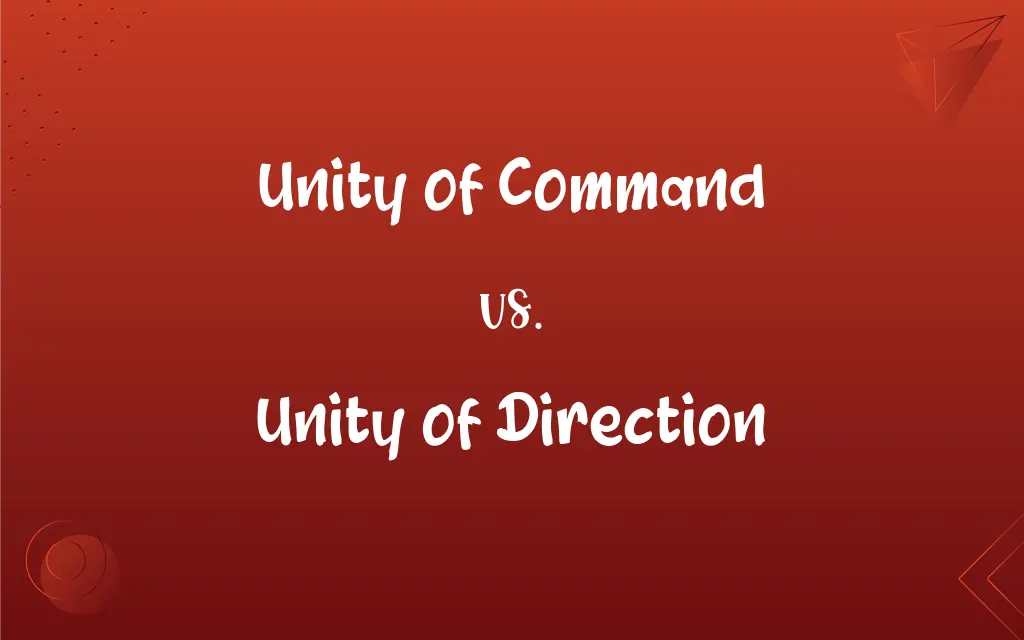Unity of Command vs. Unity of Direction: What's the Difference?
Edited by Harlon Moss || By Janet White || Published on November 24, 2023
Unity of command means an employee should receive orders from only one superior, while unity of direction implies that an organization should pursue one coordinated direction in its activities.

Key Differences
Unity of command ensures that an employee is accountable to one supervisor, avoiding confusion and conflicting instructions. While, unity of direction focuses on aligning all departmental activities toward a single strategic plan.
Unity of command is about individual reporting relationships, ensuring clear lines of authority. However, unity of direction is about coherence in organizational goals and strategies across different departments.
Unity of command helps prevent dual subordination and conflicting orders in an organization. In contrast, unity of direction ensures that all units work towards the same objectives, reinforcing the overall strategy.
In unity of command, the emphasis is on the efficiency and clarity in execution of tasks. Unity of direction, conversely, emphasizes the strategic alignment of the entire organization.
Unity of command is critical in day-to-day operations and decision-making. Unity of direction, on the other hand, is key in long-term strategic planning and organizational coherence.
ADVERTISEMENT
Comparison Chart
Definition
An employee should report to only one manager.
All organizational activities should align with a single strategy.
Focus
On individual reporting and authority.
On overall strategic alignment and direction.
Objective
To prevent confusion and conflicting orders.
To ensure coherence in achieving organizational goals.
Application
In day-to-day operations and management.
In strategic planning and organizational structure.
Benefit
Clarity in execution and accountability.
Consistency in strategy and goal orientation.
ADVERTISEMENT
Unity of Command and Unity of Direction Definitions
Unity of Command
It ensures direct and clear reporting lines in an organization.
Unity of command avoided conflicting instructions in the project team.
Unity of Direction
It aligns various departmental activities with organizational objectives.
Unity of direction ensured all departments shared the same strategic vision.
Unity of Command
Unity of command focuses on clear, individual managerial relationships.
The new manager enforced unity of command to improve efficiency.
Unity of Direction
Unity of direction means all parts of an organization work towards a single goal.
The company's success was attributed to its unity of direction.
Unity of Command
It is about singular authority and responsibility in management.
Unity of command streamlined decision-making in the company.
Unity of Direction
It ensures consistency in strategy across all organizational levels.
Unity of direction was key in implementing the new corporate strategy.
Unity of Command
Unity of command refers to receiving orders from only one superior.
Her clarity in tasks was due to the unity of command in her department.
Unity of Direction
Unity of direction involves coordinating efforts for a common purpose.
Their marketing and sales teams worked in unity of direction for the campaign.
Unity of Command
Unity of command prevents the confusion of dual subordination.
With unity of command, employees knew exactly whom to report to.
Unity of Direction
Unity of direction focuses on strategic coherence and alignment.
The CEO emphasized unity of direction in the annual general meeting.
FAQs
Why is unity of command important?
It prevents confusion and conflict from multiple command sources.
How does unity of command affect employee performance?
It clarifies roles and responsibilities, improving performance and satisfaction.
How does unity of direction benefit a company?
It aligns all departments and activities towards a common strategic goal.
Is unity of direction necessary in a diversified company?
Yes, especially to maintain strategic focus across varied business units.
What happens if unity of command is not followed?
It can lead to confusion, conflicts, and inefficiencies in operations.
How does unity of direction impact decision-making?
It ensures decisions at all levels are aligned with the overall strategy.
Is unity of direction relevant in dynamic markets?
Yes, it helps maintain strategic focus despite market changes.
Can a company have both unity of command and direction?
Yes, both can coexist and are beneficial for organizational effectiveness.
How does unity of direction facilitate growth?
It ensures all efforts are synergistically aimed at growth objectives.
How do managers implement unity of direction?
Through strategic planning and ensuring all actions support common goals.
Can unity of command apply to small teams?
Yes, it's applicable to teams of any size for clear authority and accountability.
Does unity of command restrict flexibility?
It may, but it's essential for clear communication and decision-making.
What challenges can arise from unity of command?
Over-dependence on a single leader and potential bottlenecks.
Does unity of direction help in crisis management?
Yes, by ensuring a unified approach to handling crises.
How is unity of command different in large corporations?
It may involve more complex structures but still requires clear authority lines.
Can unity of direction aid in competitive advantage?
Absolutely, through strategic focus and coherent action plans.
Is unity of command relevant in flat organizations?
Yes, it's still important for defining roles and responsibilities.
Can unity of command improve team morale?
Yes, by providing clear leadership and reducing conflicts.
How does technology affect unity of direction?
Technology can facilitate communication and alignment of strategic objectives.
Are startups in need of unity of command?
Yes, for clear guidance and effective management from the start.
About Author
Written by
Janet WhiteJanet White has been an esteemed writer and blogger for Difference Wiki. Holding a Master's degree in Science and Medical Journalism from the prestigious Boston University, she has consistently demonstrated her expertise and passion for her field. When she's not immersed in her work, Janet relishes her time exercising, delving into a good book, and cherishing moments with friends and family.
Edited by
Harlon MossHarlon is a seasoned quality moderator and accomplished content writer for Difference Wiki. An alumnus of the prestigious University of California, he earned his degree in Computer Science. Leveraging his academic background, Harlon brings a meticulous and informed perspective to his work, ensuring content accuracy and excellence.







































































